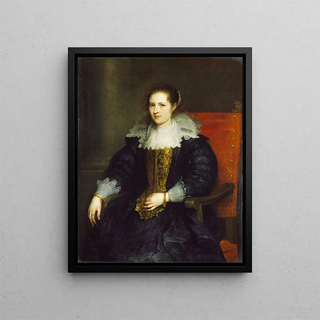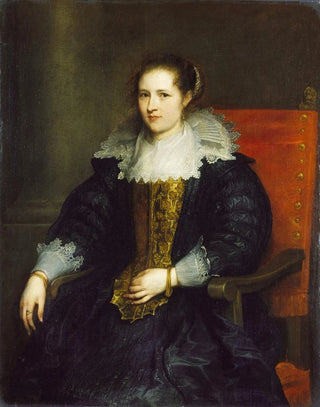Art print | Portrait of Isabella Waerbeke - Antoine van Dyck


View from behind

Frame (optional)
Portrait of Isabella Waerbeke - Antoine van Dyck – Captivating Introduction
The "Portrait of Isabella Waerbeke" by Antoine van Dyck is an iconic work that embodies the quintessence of Baroque portraiture. Created in the 17th century, this painting depicts Isabella Waerbeke, a woman of striking beauty and refined elegance. In this representation, the artist manages to capture not only the physical appearance of his model but also her inner essence, creating a timeless connection between the artwork and the viewer. The intimate atmosphere emanating from the canvas invites contemplation and admiration, revealing the subtleties of van Dyck's art, which is distinguished by its ability to immortalize the human soul through the lens of painting.
Style and uniqueness of the work
Van Dyck's style is characterized by an exceptional mastery of light and color, which gives his portraits an unparalleled emotional depth. In the "Portrait of Isabella Waerbeke," the delicacy of the female figure's features is accentuated by a palette of rich and nuanced colors. The brightness of the drapery, combined with the softness of the flesh tones, creates a striking contrast that immediately draws the eye. The artist skillfully plays with shadows and highlights, bringing the canvas to life and making Isabella's face almost alive. This portrait is not limited to a simple physical representation; it becomes a psychological exploration of the subject's personality, where every gaze, every gesture, seems to tell a story. Isabella's graceful posture, combined with her pensive expression, evokes a depth of soul and a richness of character that transcend time.
The artist and his influence
Antoine van Dyck, a pupil of Rubens, is one of the masters of Baroque portraiture. His influence on European painting is undeniable, having mastered the combination of realism with remarkable aesthetic sensitivity. Van Dyck established a style that marries the grandeur of royal portraits with a more intimate and personal approach, making his subjects accessible and human. He also played a key role in the evolution of portraiture as a genre, introducing elements of narration and

Matte finish

View from behind

Frame (optional)
Portrait of Isabella Waerbeke - Antoine van Dyck – Captivating Introduction
The "Portrait of Isabella Waerbeke" by Antoine van Dyck is an iconic work that embodies the quintessence of Baroque portraiture. Created in the 17th century, this painting depicts Isabella Waerbeke, a woman of striking beauty and refined elegance. In this representation, the artist manages to capture not only the physical appearance of his model but also her inner essence, creating a timeless connection between the artwork and the viewer. The intimate atmosphere emanating from the canvas invites contemplation and admiration, revealing the subtleties of van Dyck's art, which is distinguished by its ability to immortalize the human soul through the lens of painting.
Style and uniqueness of the work
Van Dyck's style is characterized by an exceptional mastery of light and color, which gives his portraits an unparalleled emotional depth. In the "Portrait of Isabella Waerbeke," the delicacy of the female figure's features is accentuated by a palette of rich and nuanced colors. The brightness of the drapery, combined with the softness of the flesh tones, creates a striking contrast that immediately draws the eye. The artist skillfully plays with shadows and highlights, bringing the canvas to life and making Isabella's face almost alive. This portrait is not limited to a simple physical representation; it becomes a psychological exploration of the subject's personality, where every gaze, every gesture, seems to tell a story. Isabella's graceful posture, combined with her pensive expression, evokes a depth of soul and a richness of character that transcend time.
The artist and his influence
Antoine van Dyck, a pupil of Rubens, is one of the masters of Baroque portraiture. His influence on European painting is undeniable, having mastered the combination of realism with remarkable aesthetic sensitivity. Van Dyck established a style that marries the grandeur of royal portraits with a more intimate and personal approach, making his subjects accessible and human. He also played a key role in the evolution of portraiture as a genre, introducing elements of narration and






